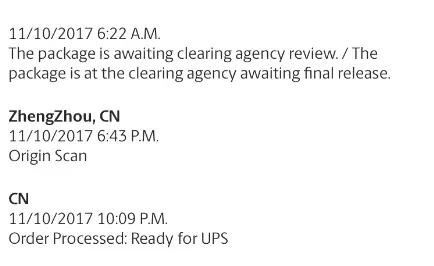When your UPS package is at the clearing agency awaiting final release, it means that it has reached the stage of customs clearance. All international shipments must go through export and import customs clearance processes to comply with regulations.
The clearing agency, often a customs authority or an agency responsible for processing international shipments, reviews documentation, assesses duties and taxes, and inspects contents if necessary.
While this process can be completed on the same day, it may take up to three days. It’s important to remember that customs clearance is a standard part of every international consignment, and you can track its progress on both the origin and destination sides.
What Happens To Your UPS Package at the Clearing Agency?
Your UPS package undergoes a series of activities at the clearing agency. This includes document verification, assessment of duties and taxes, inspection of contents if necessary, and compliance with import/export laws and regulations.

These processes ensure that your package meets the requirements for lawful entry into the destination country. Above, you’ll see a shipment status update from the UPS tracking website for reference. We’ve expanded on each of these activities below.
Inspection of Package
The first step in the customs clearance process is package inspection. The purpose of this inspection is to verify the contents of the package and ensure compliance with import and export regulations.
The inspection can either be done using scanners or a physical examination. When a package is inspected using scanners, it may go through an X-ray scanner or other specialized scanning equipment.
This allows customs officials to get a detailed view of the package’s contents without physically opening it. The scanning process helps identify any potential prohibited or restricted items, such as illegal substances or contraband. In some cases, a physical examination of the package may be necessary.
Customs officers may open the package to physically inspect its contents, especially if the scanning results raise suspicions or if the package requires further checks. During the physical examination, officers may check the items against the declared documentation to ensure accuracy and adherence to regulations.
Tax Assessment
The next step in the customs clearance process is the assessment of any applicable duties or taxes. This assessment primarily applies to the import side of international shipments, where taxes are levied based on the items being shipped and their declared value.
Documentation Review
The last step of the customs clearance process is the review of shipping documents. This review ensures that the documentation provided matches the cargo being shipped and verifies compliance with regulations.
Once the clearing agency completes the necessary procedures and approves the release of the package, the status of the shipment will be updated to reflect that the clearance was successful, and the package has been released.
This update signifies that all the required checks, including document verification, tax assessment, and any necessary inspections, have been completed satisfactorily.
What Happens After This UPS Status Update?
What happens after the UPS status update varies depending on whether the customs agency is conducting the clearance process at the origin or destination. In this section, we will take a detailed look at this process.
Next Steps: Clearance at Origin
After the package is released by customs at the origin, it will typically show one more departure scan, indicating that it has been scanned for departure on the assigned flight. Once it arrives at the destination country, it will undergo the same process on the import side for customs clearance.
Once the clearance process is complete, the package will be directed to one or more sorting or distribution centers for further processing. From there, it will be assigned to a truck for final delivery, making its way to the recipient’s specified delivery address.
This sequential journey involves multiple stages, including customs release, departure scan, import clearance, sorting, and distribution, ultimately leading to the package’s delivery to the recipient.
Next Steps: Clearance at Destination
The customs clearance process at the destination is similar to the process described earlier, however, with a focus on the final leg of its journey. After the package arrives in the destination country, it enters the UPS facilities for further handling and processing.
It is then scheduled for delivery to its intended recipient. Finally, the package undergoes the final delivery process, where a UPS driver brings it to the recipient’s designated delivery address.
Will My Package Arrive on Time When It’s Awaiting Final Release?
All packages, regardless of their origin or destination country, go through this customs clearance process. While most packages are cleared within a reasonable timeframe, you need to be mindful of certain factors that may affect the duration.
The size of the consignment or the value of the cargo can impact the clearance time. Larger shipments or high-value items may require additional scrutiny or documentation, potentially leading to a longer clearance process. Generally speaking, the customs clearance process typically takes up to three days on average. However, sometimes delays can occur due to various reasons, such as:
- Labor shortages,
- High shipping volumes, or
- Specific customs requirements.
If you notice that the package is awaiting final release for longer than the average timeframe or beyond three to four days, it is advisable to reach out to UPS for an update. They can provide you with specific information about your package’s status and offer assistance to ensure a smooth delivery experience.

Get Free Course Access
If you enjoyed the article, don’t miss out on our free supply chain courses that help you stay ahead in your industry.

Gerrit Poel
Co-Founder & Writer
at freightcourse
About the Author
Gerrit is a certified international supply chain management professional with 16 years of industry experience, having worked for one of the largest global freight forwarders.
As the co-founder of freightcourse, he’s committed to his passion for serving as a source of education and information on various supply chain topics.
Follow us